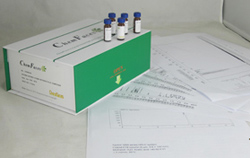Hot Products



| Catalog No. | Information |
| CFN90083 | Estriol 3-glucuronide Estradiol-3-glucuronide, estradiol-17beta-glucuronide, estriol-3-glucuronide , estrone glucuronide, estriol-16alpha-glucuronide, and pregnanediol-3alpha-glucuronide are immunoreactive metabolites of the major urinary estrogens, they have used to ovulation detection methods. |
| CFN90080 | Estriol 3-sulfate Estriol 3-sulfate acts through the hydrolyzed E3, E3-17-S is inactive because it is not hydrolyzed, so Estriol 3-sulfate can play an important role in the biological responses of this mammary cancer cell line. |
| CFN90042 | Estrone Estrone,a steroid known to play an important role as precursor of 17 beta-estradiol,especially in postmenopausal women, it inhibits the BCRP-mediated drug efflux and overcome drug resistance.The widely distributed estrone esters in food and their relatively high concentrations may result in high free hormone intakes in humans, the continued and massive intake of estrone may enhance tissue deposition and lead to obesity. |
| CFN92337 | Ethyl (E)-3'-hydroxy-4'-methoxycinnamate Reference standards. |
| CFN92310 | Ethyl (E)-ferulate Ethyl ferulate could be used for therapeutic purposes as a potent inducer of HO-1 for the protection of brain cells against oxidative and neurodegenerative conditions. |
| CFN98180 | Ethyl 4-methoxycinnamate Ethyl p-methoxycinnamate(Ethyl 4-methoxycinnamate) has antifungal activity, it can inhibit the growth of Trichophyton rubrum, Aspergillus niger, Saccharomyces cerevisiae and Epidermophyton floccosum at a concentration less than 10 mug/ml. Ethyl-p-methoxycinnamate has anti-inflammatory, it can dose-dependently inhibit carrageenan-induced edema with an MIC of 100 mg/kg, and non-selectively inhibit the activities of cyclooxygenases 1 and 2, with IC50 values of 1.12 uM and 0.83 uM respectively; it has chemopreventive activity against fibrosarcoma through inhibition of COX-2, and can block bFGF-induced vessel formation on Matrigel plug assay in vivo. Ethyl p-methoxycinnamate could be developed as a skin whitening agent to treat hyperpigmentary disorders. |
| CFN99849 | Ethyl beta-D-fructofuranoside Ethyl beta-D-fructofuranoside shows positive anti-tumor cells migration effects. |
| CFN97136 | Ethyl caffeate Ethyl caffeate is a potent chemopreventive compound against skin carcinogenesis caused by solar UV exposure, it strongly inhibits neoplastic transformation of JB6 Cl41 cells without toxicity. PI3K, ERK1/2, and p38 kinase activities were suppressed by direct binding with HOEC in vitro. Ethyl caffeate also has anti-inflammatory, hepatprotective activities. |
| CFN98199 | Ethyl cinnamate Ethyl cinnamate has antifungal, and vasorelaxant effects, it can inhibit the tonic contractions induced by high K+ and phenylephrine (PE) in a concentration-dependent manner, with respective IC50 values of 0.30 +/- 0.05 mM and 0.38 +/- 0.04 mM. Ethyl cinnamate can lead to the damage of cell membrane system and metabolic disorder through inducing lipid peroxidation via initiating ROS overproduction.Ethyl cinnamate has acute inhibition to the maximum quantum yield and the potential activity of photosystem II of Chlorella pyrenoidosa. |
| CFN99767 | Ethyl ferulate Ethyl ferulate has anti-inflammatory property, can reduce HIV replication, it shows inhibitive effect on platelet congregation induced by ADP. It also is a potent inducer of HO-1 for the protection of brain cells against oxidative and neurodegenerative conditions. |